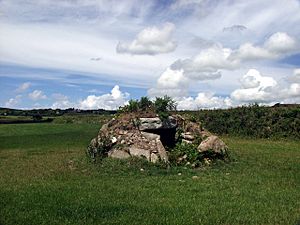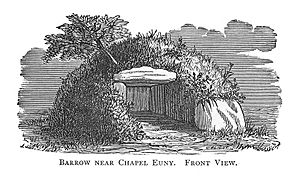Brane Barrow facts for kids
Quick facts for kids Brane Barrow |
|
|---|---|
 |
|
| Location | Cornwall |
| Built | c.2500-1000 BC |
| Lua error in Module:Location_map at line 420: attempt to index field 'wikibase' (a nil value). | |
Brane Barrow, also known as Chapel Euny Barrow, is a very old Neolithic (New Stone Age) burial site. It is a special type of entrance grave found near the small village of Brane, in Cornwall, England. Many people think it is one of the smallest and best-kept ancient burial places in Britain.
What are Entrance Graves?
Entrance graves are ancient burial sites that were built during the later Neolithic period and the Bronze Age. This was a very long time ago, between about 2500 BC and 1000 BC.
Most entrance graves are round. They were made from a mound of piled-up rocks and soil. These mounds could be quite large, sometimes up to 82 feet (25 meters) across. A border of stones, called a kerbstone, often went around the edge of the mound.
Inside the mound was a rectangular room, or chamber. This chamber was built with large stone slabs or carefully stacked stones. Big flat stones, called capstones, formed the roof of the chamber. People could get into the chamber through an opening in the mound's outer edge.
The Story of Brane Barrow
Brane Barrow was first found by a man named William Copeland Borlase in 1863. He was exploring another underground place nearby, which was probably Carn Euny.
Borlase called this site the "barrow near Chapel Euny" because it was close to that village. The farmer who owned the land told Borlase that he had not destroyed the barrow. This was because it made a good shelter for his sheep and pigs!
What Does Brane Barrow Look Like?
Brane Barrow is a protected ancient monument. It is located about 317 yards (290 meters) southwest of Brane End Farm. It is also about 1.2 miles (2 kilometers) southwest of the village of Sancreed in Cornwall. This ancient grave sits in a low, grassy field near the top of the Lamorna River.
The barrow is a round mound of earth and stones. It measures about 20 feet (6.1 meters) across. Large granite blocks form a border around the mound, holding it in place.
Inside the mound is a rectangular stone room. This room is about 7.5 feet (2.3 meters) long, 4 feet (1.2 meters) wide, and 3 feet (0.9 meters) high. Two large capstones form the roof of this chamber. A third capstone was once there but was removed a long time ago.
On the southeast side, there is a passage that leads right into the chamber. It is a bit unusual because the mound was built to just barely cover the chamber. The south side of the mound is a little damaged where some earth has been taken away, showing the chamber more clearly. You can visit this ancient burial site if you get permission from Brane farm.


